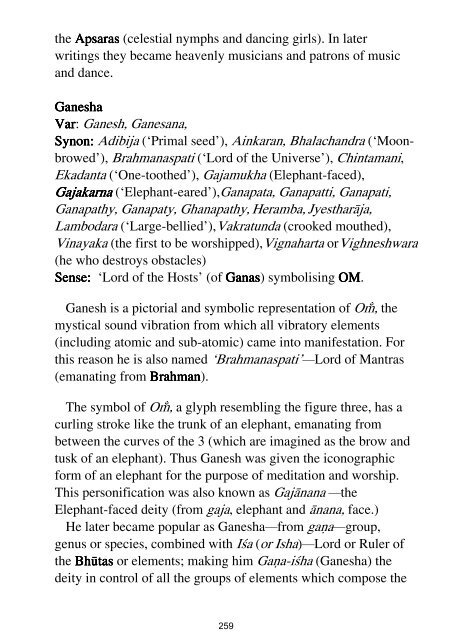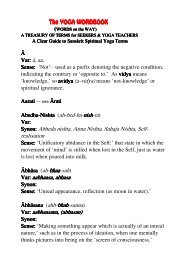Words on the Way - Muz Murray Mantra Yoga Master
Words on the Way - Muz Murray Mantra Yoga Master
Words on the Way - Muz Murray Mantra Yoga Master
Create successful ePaper yourself
Turn your PDF publications into a flip-book with our unique Google optimized e-Paper software.
<strong>the</strong> Apsaras (celestial nymphs and dancing girls). In later<br />
writings <strong>the</strong>y became heavenly musicians and patr<strong>on</strong>s of music<br />
and dance.<br />
Ganesha<br />
Var: Ganesh, Ganesana,<br />
Syn<strong>on</strong>: Adibija (‘Primal seed’), Ainkaran, Bhalachandra (‘Mo<strong>on</strong>browed’),<br />
Brahmanaspati (‘Lord of <strong>the</strong> Universe’), Chintamani,<br />
Ekadanta (‘One-too<strong>the</strong>d’), Gajamukha (Elephant-faced),<br />
Gajakarna (‘Elephant-eared’),Ganapata, Ganapatti, Ganapati,<br />
Ganapathy, Ganapaty, Ghanapathy, Heramba, Jyestharåja,<br />
Lambodara (‘Large-bellied’),Vakratunda (crooked mou<strong>the</strong>d),<br />
Vinayaka (<strong>the</strong> first to be worshipped),Vignaharta orVighneshwara<br />
(he who destroys obstacles)<br />
Sense: ‘Lord of <strong>the</strong> Hosts’ (of Ganas) symbolising OM.<br />
Ganesh is a pictorial and symbolic representati<strong>on</strong> of O, <strong>the</strong><br />
mystical sound vibrati<strong>on</strong> from which all vibratory elements<br />
(including atomic and sub-atomic) came into manifestati<strong>on</strong>. For<br />
this reas<strong>on</strong> he is also named ‘Brahmanaspati’—Lord of <strong>Mantra</strong>s<br />
(emanating from Brahman).<br />
The symbol of O, a glyph resembling <strong>the</strong> figure three, has a<br />
curling stroke like <strong>the</strong> trunk of an elephant, emanating from<br />
between <strong>the</strong> curves of <strong>the</strong> 3 (which are imagined as <strong>the</strong> brow and<br />
tusk of an elephant). Thus Ganesh was given <strong>the</strong> ic<strong>on</strong>ographic<br />
form of an elephant for <strong>the</strong> purpose of meditati<strong>on</strong> and worship.<br />
This pers<strong>on</strong>ificati<strong>on</strong> was also known as Gajånana —<strong>the</strong><br />
Elephant-faced deity (from gaja, elephant and ånana, face.)<br />
He later became popular as Ganesha—from ga~a—group,<br />
genus or species, combined with Iça (or Isha)—Lord or Ruler of<br />
<strong>the</strong> Bh¨tas or elements; making him Ga~a-içha (Ganesha) <strong>the</strong><br />
deity in c<strong>on</strong>trol of all <strong>the</strong> groups of elements which compose <strong>the</strong><br />
259



